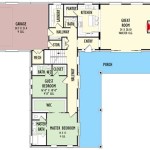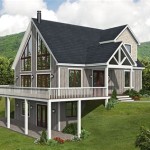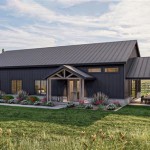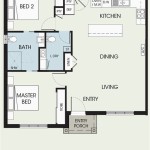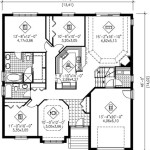Two-Bedroom One-Story House Plans: A Comprehensive Guide
The appeal of two-bedroom, one-story house plans lies in their practicality, affordability, and accessibility. These plans cater to a diverse range of homeowners, from first-time buyers and empty nesters to individuals with mobility concerns. A single-story layout eliminates stairs, promoting ease of movement and simplifying household chores. The two-bedroom format offers sufficient space for a small family, a couple, or a single individual seeking a guest room or home office. This article explores the key considerations, benefits, and design options associated with two-bedroom, one-story house plans.
Understanding the Target Demographic
Two-bedroom, one-story house plans are particularly well-suited for several distinct demographic groups. Retirees and empty nesters often seek to downsize from larger multi-story homes to more manageable living spaces. The single-story design removes the challenges posed by stairs, allowing for aging in place. Young couples or single individuals entering the housing market often find these plans to be an affordable and practical entry point. The two bedrooms can serve as a master bedroom and a guest room or a home office. Furthermore, individuals with mobility impairments benefit greatly from the accessibility offered by a single-story layout. The absence of stairs promotes independent living and reduces the risk of falls.
Key Considerations in Two-Bedroom, One-Story Design
Several critical factors must be considered when selecting or designing a two-bedroom, one-story house plan. These factors influence the functionality, aesthetics, and overall livability of the home. Effective space planning is paramount, especially in a smaller footprint. Careful consideration must be given to the layout of rooms, the placement of doorways and windows, and the use of built-in storage solutions. Natural light is another essential element. Maximizing natural light through strategically positioned windows and skylights can create a brighter and more inviting interior. Furthermore, ventilation is crucial for maintaining air quality and preventing moisture buildup. Adequate ventilation can be achieved through the placement of windows and the incorporation of features such as ceiling fans and ventilation systems.
Accessibility is a major advantage of single-story homes and should be addressed during the planning phase. Wider doorways, accessible bathrooms, and ramps or level entryways can make the home more user-friendly for individuals with mobility limitations. Energy efficiency is an increasingly important consideration for homeowners. Incorporating energy-efficient windows, insulation, and appliances can significantly reduce energy consumption and lower utility bills. Finally, outdoor space is a valuable asset that can enhance the livability of a small home. Patios, decks, and gardens can provide opportunities for relaxation, entertainment, and connection with nature.
Exploring Different Architectural Styles
Two-bedroom, one-story house plans can be adapted to a wide range of architectural styles, each with its unique aesthetic appeal. Ranch-style homes are characterized by their low-pitched roofs, horizontal layouts, and simple, clean lines. They often feature large windows and open floor plans, promoting a sense of spaciousness and connection to the outdoors. Cottage-style homes evoke a sense of charm and coziness with their gabled roofs, dormer windows, and quaint details. They typically feature smaller footprints and emphasize comfort and practicality. Modern-style homes are defined by their clean lines, minimalist aesthetics, and use of modern materials such as glass, steel, and concrete. They often incorporate open floor plans, large windows, and energy-efficient features.
Craftsman-style homes are known for their attention to detail, handcrafted elements, and use of natural materials such as wood and stone. They typically feature low-pitched roofs, wide eaves, and exposed rafters. Farmhouse-style homes are inspired by traditional rural architecture, featuring simple, functional designs and a focus on practicality. They often incorporate elements such as porches, gable roofs, and shiplap siding. Ultimately, the choice of architectural style depends on the homeowner's personal preferences, the surrounding environment, and the desired aesthetic.
Space-Saving Strategies for Compact Living
Maximizing space is crucial in a two-bedroom, one-story house plan. Employing space-saving strategies can create a more functional and comfortable living environment. Open floor plans are a popular choice for small homes, as they create a sense of spaciousness and allow for flexible use of the living areas. Combining the living room, dining area, and kitchen into a single open space can eliminate the need for walls and create a more fluid and inviting flow.
Built-in storage solutions are invaluable for maximizing space and minimizing clutter. Built-in bookshelves, cabinets, and benches can provide ample storage without taking up valuable floor space. Multi-functional furniture is another effective strategy. Convertible sofas, coffee tables with storage, and folding dining tables can serve multiple purposes and adapt to different needs. Vertical storage is also a valuable asset. Utilizing wall space for shelves, cabinets, and hanging organizers can free up floor space and keep items organized. Finally, minimizing clutter is essential for creating a sense of spaciousness. Regularly decluttering and organizing belongings can make a small home feel larger and more comfortable.
Adapting to Changing Needs
While two-bedroom, one-story house plans are well-suited for a variety of lifestyles, it's important to consider how the home can adapt to changing needs over time. Flexible spaces are crucial for accommodating different stages of life. A guest room can be easily converted into a home office, a nursery, or a hobby room as needed. Expandable designs allow for future additions or modifications. Adding a sunroom, a patio, or a garage can increase the living space and functionality of the home. Universal design principles can be incorporated to ensure that the home remains accessible and comfortable for individuals of all ages and abilities. These principles include features such as wider doorways, grab bars in bathrooms, and lever-style door handles.
Smart home technology can also enhance the adaptability and functionality of the home. Smart lighting, thermostats, and security systems can improve energy efficiency, security, and convenience. Finally, regular maintenance and updates are essential for preserving the value and functionality of the home. Keeping the roof, plumbing, and electrical systems in good repair can prevent costly repairs and ensure that the home remains a comfortable and safe living environment.
Cost Considerations and Budgeting
The cost of building or purchasing a two-bedroom, one-story home can vary significantly depending on several factors, including location, materials, and labor costs. Establishing a realistic budget is essential for ensuring a successful project. Construction costs typically account for a significant portion of the overall budget. Obtaining multiple bids from reputable contractors can help to ensure that you are getting a fair price. Material costs can also vary widely depending on the quality and type of materials selected. Choosing durable, energy-efficient materials can save money in the long run by reducing maintenance and energy costs.
Land costs are another major consideration. The price of land can vary dramatically depending on location and zoning regulations. Design fees can also add to the overall cost. Working with an architect or designer can help you create a plan that meets your needs and budget. Permit fees are required for most construction projects. These fees can vary depending on the location and the scope of the project. Finally, contingency funds are essential for covering unexpected expenses that may arise during construction. Setting aside a contingency fund of 5-10% of the total budget can provide a cushion for unforeseen costs.
Benefits of Single-Story Living
Single-story living offers a multitude of benefits that contribute to a comfortable and convenient lifestyle. Accessibility is a primary advantage, particularly for individuals with mobility limitations. The absence of stairs eliminates the risk of falls and allows for easier navigation throughout the home. Easier maintenance is another significant benefit. Cleaning, repairs, and maintenance tasks are simplified in a single-story home, as there are no stairs to climb or multiple levels to navigate. Improved safety is also a key advantage. Evacuating a single-story home in case of a fire or other emergency is much easier and faster than evacuating a multi-story home. Single story homes often promote a stronger connection to the outdoors. Patios, decks, and gardens are easily accessible, allowing for seamless integration of indoor and outdoor living spaces.
Enhanced energy efficiency can also be achieved in a single-story home. Heat rises, so single-story homes tend to be easier to heat and cool than multi-story homes. Finally, single-story homes often offer a quieter and more private living environment. There are no upstairs neighbors or internal stairs to generate noise, creating a more peaceful and tranquil atmosphere.
Selecting the Right Plan
Choosing the right two-bedroom, one-story house plan requires careful consideration of personal needs, lifestyle, and budget. Defining your needs is the first step. Determine the number of bedrooms, bathrooms, and living spaces required. Consider any special features or amenities that are important to you, such as a home office, a large kitchen, or a screened-in porch. Lifestyle considerations are also important. Think about how you will use the space and how your lifestyle will impact the design of the home. Do you entertain frequently? Do you work from home? Do you have children or pets? The plan should align with the homeowner's daily activities. Evaluating the layout is a crucial step. Ensure that the layout is functional and efficient, with a good flow between rooms. Consider the placement of windows and doors, and the amount of natural light in each room.
Assessing storage needs is also essential. Make sure that the plan provides adequate storage space for your belongings. Consider built-in storage solutions, such as closets, cabinets, and shelves. Reviewing the site plan is important. Ensure that the plan is compatible with the building site, taking into account factors such as topography, orientation, and zoning regulations. Seeking professional advice from an architect or designer can be invaluable. They can help you select the right plan, customize it to your needs, and ensure that it meets all building codes and regulations. Finally, carefully reviewing the budget is important before committing. Ensure that the plan fits within your budget, taking into account all costs, including construction, materials, and fees.

Small One Story 2 Bedroom Retirement House Plans Houseplans Blog Com

Small One Story 2 Bedroom Retirement House Plans Houseplans Blog Com

2 Bedroom House Floor Plan Plans One Y

House Plan 64557 One Story Style With 1152 Sq Ft 2 Bed Bath

House Plan 64528 One Story Style With 1097 Sq Ft 2 Bed 1 Bath

Small One Story 2 Bedroom Retirement House Plans Houseplans Blog Com

Small Low Cost Economical 2 Bedroom Bath 1200 Sq Ft Single Story House Floor Plans Blu One

Our Best Small 2 Bedroom One Story House Plans And Floor

Extremely Gorgeous 2 Bedroom House Plans Pinoy Designs

2 Bedroom House Plans Monster


